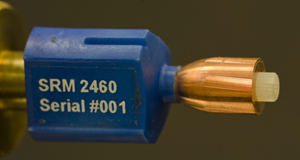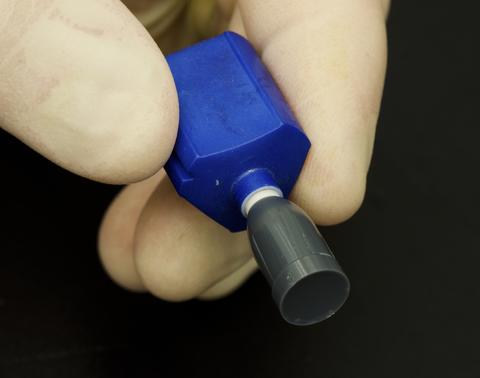At a time when the reliability of crime lab findings is under increasing scrutiny, PML researchers have provided law enforcement with an important new tool for improving ballistic analysis – a Standard Reference Material Cartridge Case (SRM 2461) to complement the existing NIST Standard Bullet (SRM 2460). Approximately 200 crime laboratories across the nation use microscope imaging systems to acquire digital images of fired bullets and cartridge casings. These images are compared in a nationwide database, and positive matches are frequently submitted into evidence at criminal trials. The NIST standards were developed to check or verify the calibration of these microscopes and to provide quality control. (For a short video about the casing project, click here.)
The new Cartridge Case, which has just become available at $302 per unit, contains reference markings for the three major topographical "signatures" created on the casing when a weapon is fired: firing pin impression, breech face impression, and ejector mark. It is expected to have a substantial impact because, by one estimate, about 10,000 bullets and more than 200,000 cartridge casings are examined by forensic labs in the United States every year. It is critical that these labs have a reference standard that they can use for instrument calibration and quality control.
"Suppose a casing is recovered from a crime scene in California," says Thomas Brian Renegar of PML's Semiconductor and Dimensional Metrology Division, "and a firearm is later recovered in Kansas that police suspect was used in the crime. Digital images of the California casings are entered into a nationwide database along with images of test-fired casings from the Kansas gun. Firearms examiners look to see if the images match, which would be an indication that the casings were fired from the same gun. But the accuracy of their comparisons depends critically on whether the computerized optical-imaging equipment in those labs is operating properly and has been calibrated to a recognized, authoritative standard."
"Unless the accuracy of the imaging microscopes can be confirmed, the lab results may be successfully questioned in court, or simply not admitted into evidence in the first place."
It was the need for such standards that led NIST to produce the first 9 mm reference bullet in 2006 at the request of the Bureau of Alcohol, Tobacco, and Firearms (ATF). A group of pure copper blanks was fabricated, and a computerized diamond cutting tool was used to machine the surface of each with a set of six different characteristic striations, or "land impressions," similar to those on real fired bullets. These topographic markings are typically produced by the helical rifling in a gun barrel during a bullet firing.
However, by instead manufacturing the standard bullets using a computerized machining process, the bullet striations could be controlled extremely precisely. Researchers from PML's Surface and Nanostructure Metrology Group selected several dozen of the units that were virtually identical and NIST certified them as Standard Reference Materials.
The degree of similarity between the Standard Bullets is quantitatively assessed by measuring the surface topography of each and then using mathematical correlation algorithms to compare them to the reference master. "The discriminating features on the bullets are on the order of micrometers in size," Renegar says, "and the average correlation of each individual Standard Bullet is more than 98.5% compared to our reference bullet signatures."
Each SRM is accompanied by a calibration certificate which includes a physical description of the standard, analysis and uncertainty estimates, and a user's guide for forensic lab examination. Also provided is a control limit value determined by the Statistical Engineering Division at NIST that specifies the lowest acceptable correlation value.
Also essential is the "golden image" -- NIST's reference measurements of markings on the standard bullet, which are available on a public database. "If a crime lab buys a standard bullet," Renegar says, "they can examine it and compare their data to the golden image. Moreover, they can check the reproducibility of their measurements over time intervals of weeks or months. If, for example, they suddenly get a drop in the correlation value to below the control limit, they'll see it immediately and know something is wrong with the images acquired, either by operator error or microscope malfunction, and so forth."

"Of course, we had to examine every single one to make sure there were no defects," Renegar says. "Still, we have more than 100 units that will be sold by NIST's SRM office. And because of the replication technique used, they are relatively inexpensive – something that crime labs can afford and that they will use quite a bit."
That is, however, by no means the end of the story. Recent research conducted by NIST for a National Academies study in 2007, which led to a NIST IR (NISTIR 7362), concluded that the conventional optical microscope imaging systems used by most crime labs are less accurate than techniques and instruments that can generate topographic data from the true surface geometry – for example, tracing a stylus over bullet striations to obtain a 2D surface profile, or using confocal or interferometric microscopes to generate 3D topographic images of depth and contour.
Renegar and colleagues are now at work designing the next version of the Standard Bullet. They are currently testing low-cost, high-quality substitutes for the first-generation solid-copper SRM bullets that sold for $2000 each.

The results have been gratifying. "At first, even though there were quality problems with micro-bubbles in the replicas, we were still getting correlation values over 97%," Renegar says. After improving the technique, the micro-bubbles have been eliminated and the replicas are virtually indistinguishable from the master bullet they were made from. We're also getting correlation values up to 99.37% now."

